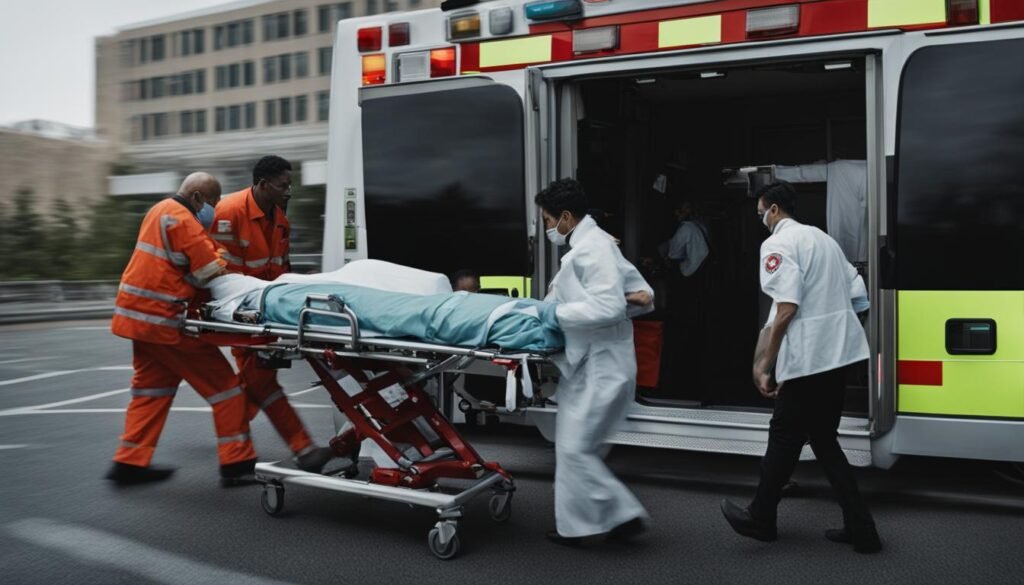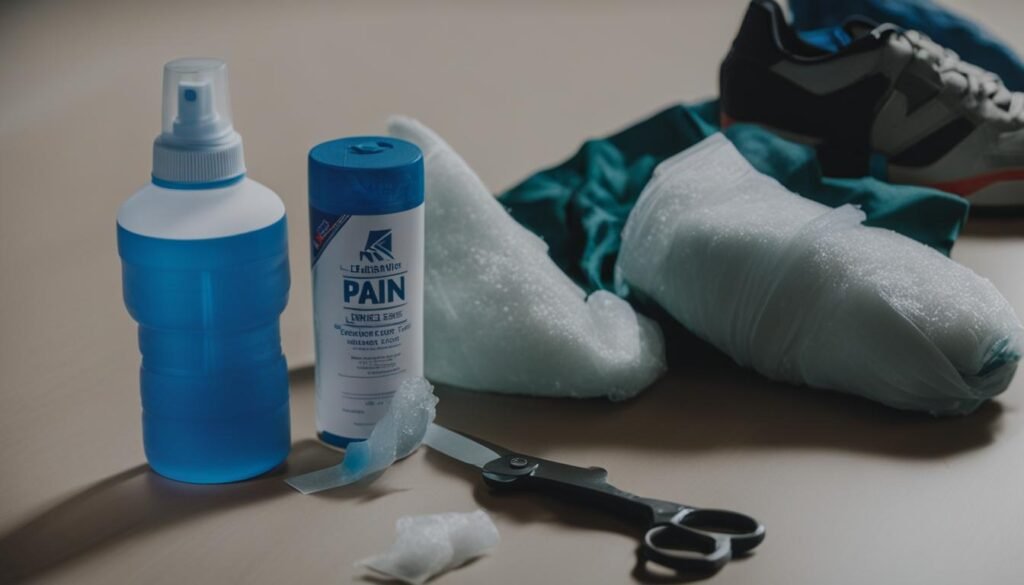A fracture, or a broken bone, is a serious injury that requires immediate medical attention. Knowing how to perform first aid for a fracture can help minimize further damage and provide temporary relief until professional help arrives. Whether it’s a simple break or a complex fracture, taking the right steps can make a significant difference in the outcome of the injury.
In this article, I will discuss the necessary first aid steps for treating a fracture in an emergency situation. From recognizing the symptoms to providing initial care and seeking professional help, every aspect of fracture management will be covered to ensure you have the knowledge to handle this critical situation effectively.
Key Takeaways:
- Fractures require immediate medical attention, especially if they are the result of major trauma or injury.
- Calling 911 or the local emergency number is crucial in cases of severe fractures or associated complications.
- While waiting for medical help, steps such as stopping bleeding, immobilizing the injured area, applying ice packs, and treating for shock can be taken.
- Recognizing the symptoms of a broken bone, such as intense pain, visible deformity, and swelling, is essential for providing appropriate care.
- Performing first aid for a fracture involves stopping bleeding, immobilizing the injured area, applying cold packs, and treating for shock.
Recognizing the Symptoms of a Broken Bone
When it comes to a broken bone, recognizing the symptoms is key to ensuring prompt and appropriate care. Here are the signs you should look out for:
- Intense pain: A broken bone can cause severe pain in the affected area, particularly when moved or touched.
- Numbness: If you experience numbness in the injured area, it could be a sign of nerve damage associated with a broken bone.
- Bluish color and swelling: The injured area may appear bluish in color and become swollen due to the internal bleeding caused by the fracture.
- Visible deformity: In some cases, a broken bone may result in an obvious deformity or misalignment.
- Bone protrusion: In more severe fractures, the bone may break through the skin, causing a visible protrusion.
- Heavy bleeding: It’s important to note that heavy bleeding at the injury site can occur.
Recognizing these symptoms can help you determine whether you or someone else has a broken bone and requires immediate medical attention. It’s crucial to take these signs seriously and seek professional care as soon as possible.
Providing First-Aid Care for a Broken Bone
If someone is suspected to have a broken bone, providing first-aid treatment is crucial before seeking professional help. Here are the steps you can take:
- Stop any bleeding by elevating and applying pressure to the wound using a sterile bandage or clean cloth. This helps prevent excessive blood loss and promotes clotting.
- Immobilize the injured area with a splint or sling if it’s a limb fracture. This helps prevent further damage and minimizes pain during transportation. For suspected neck or back fractures, keep the person as still as possible.
- Apply cold to the area with an ice pack or a cloth-wrapped bag of ice. This helps reduce swelling, inflammation, and pain. Remember to put a cloth barrier between the ice and the skin to avoid direct contact.
- Treat the person for shock by making them comfortable and maintaining warmth. Shock can occur as a result of severe pain and emotional distress, so providing reassurance and support is important.
If the person is unconscious or not breathing, CPR should be initiated immediately, and emergency help should be sought.
First-Aid Steps for a Broken Bone
| Step | Action |
|---|---|
| 1 | Stop any bleeding by elevating and applying pressure to the wound. |
| 2 | Immobilize the injured area with a splint or sling. |
| 3 | Apply cold to the area with an ice pack |
| 4 | Treat the person for shock by making them comfortable and maintaining warmth. |
Quote
“Providing immediate first-aid care for a broken bone can help minimize pain, prevent further injury, and promote healing. Remember to immobilize the injured area, apply cold to reduce swelling, and treat for shock. It’s important to seek professional help if the person’s condition worsens or if there are signs of severe injury.”
– Dr. Rebecca Johnson, Orthopedic Surgeon
Seeking Professional Help for a Broken Bone
In most cases of broken bones, professional medical care is necessary. If you or someone around you is experiencing severe symptoms, it is important to seek immediate assistance. For emergencies such as difficulty breathing, unconsciousness, or heavy bleeding, it is crucial to call 911 for immediate help.
However, if the person’s condition is stable enough, it may be possible to transport them to the emergency department by car or other means. This will allow them to receive a proper diagnosis and appropriate treatment from a doctor.
When a broken bone occurs, professional care offers many advantages. Healthcare providers in the emergency department are equipped to handle fractures and have the necessary knowledge and resources to address the injury effectively. They can provide a thorough evaluation, including X-rays or other imaging tests, to determine the extent and location of the fracture. This diagnostic process is essential for determining the appropriate treatment plan.
Once the fracture is diagnosed, healthcare professionals can provide the necessary treatment to ensure the bone heals properly. They may realign the bone if needed, provide pain management, and offer guidance on immobilization techniques or the use of assistive devices like slings, casts, or splints. Following their expert advice and treatment plan is crucial for a successful recovery.

When seeking professional help for a broken bone, time is of the essence. Prompt medical attention can help prevent further complications and promote optimal healing. Remember, healthcare providers are trained to handle emergencies and are best equipped to provide the necessary professional care for a broken bone.
How to Handle a Broken Bone at Home
While seeking professional help is important, there are some steps that can be taken to manage a broken bone at home before medical assistance arrives. These home care measures can help alleviate pain and provide temporary support for the injured area.
1. Keep the Injured Area Still
It is crucial to keep the injured area as still as possible to avoid further damage or pain. Avoid any unnecessary movement or attempts to realign or push back a bone that may be sticking out. Immobilization is important in preventing further injury and promoting proper healing.
2. Apply Ice Packs
Ice packs can help reduce swelling and limit pain in the affected area. Wrap a bag of ice or a cold pack in a cloth and apply it gently to the injured area for about 15 to 20 minutes at a time. Remember to place a barrier, such as a thin cloth or towel, between the ice pack and the skin to prevent ice burn.
3. Provide Support with a Splint
If you have the necessary training, you can provide temporary support for the broken bone by applying a splint. A splint helps immobilize the affected area and reduces the risk of further injury. Ensure the splint is padded and secure, but not too tight, to avoid interfering with blood circulation.
Note: It is essential to remember that these home care measures should be seen as temporary solutions until professional medical care can be obtained. Seeking medical attention is crucial for a proper diagnosis and treatment plan.
While managing a broken bone at home can provide some relief and support, it is important to consult a healthcare professional to ensure proper care and follow-up treatment. A doctor will be able to assess the severity of the fracture, provide appropriate medical interventions, and guide you through the recovery process.
First-Aid Steps for Managing a Broken Bone at Home
| Step | Description |
|---|---|
| 1 | Keep the injured area still and avoid attempting to realign the bone |
| 2 | Apply ice packs wrapped in a cloth to reduce swelling and pain |
| 3 | If trained, provide support with a padded splint |
| 4 | Seek professional medical care for a proper diagnosis and treatment plan |
Remember, proper diagnosis and treatment from a healthcare professional are essential for a complete recovery and the best possible outcome for a broken bone.
Tips for Preventing Fractures
Preventing fractures is essential for maintaining healthy bones and overall well-being. By taking certain precautions in your daily life, you can significantly reduce the risk of fractures and protect your bone health.
1. Wear appropriate safety equipment
When participating in physical activities or sports that carry a risk of falls or collisions, it is crucial to wear the right safety equipment. This includes helmets for activities like cycling or skiing, knee pads for skating or basketball, and wrist guards for skateboarding or rollerblading. Using appropriate safety gear can help cushion the impact and protect your bones from fractures.
2. Practice good posture and balance
Developing and maintaining good posture and balance is key to prevent falls and potential fractures. By strengthening your core muscles and improving your balance through exercises like yoga or tai chi, you can enhance stability and reduce the risk of accidents that may lead to fractures.
3. Maintain a healthy diet rich in calcium and vitamin D
Proper nutrition plays a crucial role in maintaining strong and healthy bones. Ensure your diet includes foods that are rich in calcium, such as dairy products, leafy greens, and fortified cereals. Additionally, vitamin D is essential for calcium absorption and bone health, so it is important to get adequate sunlight exposure and consume foods like fatty fish and fortified dairy products.
4. Avoid risky behaviors and environments
Being mindful of your surroundings and avoiding risky behaviors can significantly reduce the likelihood of accidents and fractures. For example, refrain from engaging in activities that involve excessive speed, heights, or potential hazards. Take precautions when walking on slippery surfaces or uneven terrain to prevent falls that may result in fractures.
5. Engage in regular exercise
Regular exercise that focuses on strengthening muscles and improving bone density can contribute to fracture prevention. Weight-bearing exercises like walking, jogging, or lifting weights help to strengthen bones and reduce the risk of fractures. Additionally, activities that enhance balance and coordination, such as dancing or Pilates, can also be beneficial in preventing falls and fractures.
6. Get regular check-ups and bone density screenings
Regular check-ups with your healthcare provider can help monitor your bone health and provide early detection of any potential issues. Depending on your age and risk factors, your doctor may recommend bone density screenings to assess your bone strength and identify any signs of osteoporosis or decreased bone density.
By following these fracture prevention tips, you can take proactive steps to protect your bones and minimize the risk of fractures. Remember, maintaining a healthy lifestyle, engaging in regular exercise, and seeking professional advice when needed are key to preserving your bone health.

Types of Fractures
Fractures can occur in various ways and can range from simple to complex. Understanding the different types of fractures is essential for proper diagnosis and treatment. Some common types of fractures include:
- Stable fractures: These fractures occur when the broken ends of the bone line up properly and remain in position. They are less likely to require surgery and have a shorter recovery time.
- Compound fractures: Also known as open fractures, these occur when the broken bone pierces through the skin or when there is a visible wound at the fracture site. These fractures have a higher risk of infection and may require immediate medical attention.
- Greenstick fractures: Common in children, these fractures occur when the bone bends and cracks but does not completely break. The bone may appear to be only partially fractured.
- Compression fractures: These fractures often occur in the vertebrae and result from the collapse of a weakened bone due to conditions like osteoporosis or trauma. Compression fractures can cause severe pain and may lead to spinal deformity.
- Transverse fractures: These fractures occur when the break is at a right angle to the long axis of the bone. They are often caused by direct force or trauma.
- Oblique fractures: These fractures occur when the break is at an angle to the long axis of the bone. They are typically caused by rotational forces.
“It is crucial to identify the type of fracture accurately as it guides the treatment approach and helps predict the healing process.”
Proper diagnosis of a fracture requires a thorough examination, imaging tests such as X-rays or CT scans, and consultation with a healthcare professional. In some cases, additional tests like MRI or bone scans may be necessary to assess the extent of the injury. Treatment options will vary depending on the type and severity of the fracture, and may include immobilization with casts or splints, realignment (reduction), surgical intervention, or a combination of these approaches.
Understanding Fracture Classification
Fractures are classified based on various factors, including the location of the fracture, the direction of the break, the number of broken pieces, and the presence of associated injuries. This classification system helps healthcare professionals communicate effectively and determine the most appropriate treatment plan. Some commonly used fracture classification systems include:
- The AO/OTA classification system: This system categorizes fractures based on the location and pattern of the fracture, allowing doctors to better understand the injury and plan appropriate treatment.
- The Salter-Harris classification: This classification specifically applies to fractures involving the growth plates in children. It helps identify the severity of the fracture and predict potential complications.
- The Gustilo-Anderson classification: This system classifies compound fractures based on the severity and extent of soft tissue damage.
These classification systems assist in standardizing communication among healthcare professionals and contribute to better treatment outcomes for patients.
Complications and Risks Associated with Fractures
Fractures can lead to various complications and risks if not properly treated. It is essential to understand these potential issues to ensure appropriate care and minimize long-term consequences.
Complications of Fractures
1. Infection: Fractures that break through the skin, known as open fractures, pose an increased risk of infection. Bacteria can enter the body through the open wound, leading to localized or systemic infection that may require antibiotics or even surgery to treat.
2. Delayed Union: In some cases, bones may take longer than usual to heal or fail to heal completely. This occurrence, known as delayed union, can result from factors such as poor blood supply, inadequate immobilization, or underlying medical conditions.
3. Nonunion: Nonunion refers to a situation where the fractured bone fails to heal entirely. This can be due to severe displacement, inadequate blood supply, or infection. Treatments for nonunion typically involve surgical intervention, such as bone grafting or the use of electrical bone stimulation.
4. Malunion: Malunion occurs when a bone heals in an improper alignment or position. It can lead to pain, limited function, and cosmetic deformity. Depending on the severity, malunion may require corrective surgeries, such as osteotomy, to realign and stabilize the bone.
Risks Associated with Fractures
1. Compartment Syndrome: Fractures accompanied by significant swelling or internal bleeding may exert pressure within the surrounding muscle compartments. This increased pressure can compromise blood flow and lead to a condition called compartment syndrome, which requires urgent surgical intervention to relieve pressure and restore blood supply.
2. Nerve or Blood Vessel Damage: Fractures can sometimes injure surrounding nerves or blood vessels, leading to sensory loss, weakness, or compromised blood circulation. Nerve damage may require specialized treatment, such as physical therapy, while vascular injuries may necessitate surgical repair.
3. Deep Vein Thrombosis (DVT): Immobility following a fracture can increase the risk of developing blood clots, known as deep vein thrombosis (DVT). If left untreated, these clots can migrate to the lungs and cause a pulmonary embolism, a life-threatening condition. Prophylactic measures such as early mobilization, compression stockings, and anticoagulant medication may be recommended to minimize the risk of DVT.
4. Joint Stiffness and Muscle Weakness: Prolonged immobilization of a fractured limb can lead to joint stiffness and muscle weakness. Physical therapy and rehabilitation are essential to regain range of motion, strength, and functional abilities in the affected area.
5. Psychological Impact: The emotional and psychological impact of a fracture should not be overlooked. The physical limitations, pain, and potential changes in appearance can lead to anxiety, depression, or a decrease in quality of life. Support from healthcare professionals, family, and friends can play a vital role in the emotional recovery of individuals.
| Complications | Risks |
|---|---|
| Infection | Compartment Syndrome |
| Delayed Union | Nerve or Blood Vessel Damage |
| Nonunion | Deep Vein Thrombosis (DVT) |
| Malunion | Joint Stiffness and Muscle Weakness |
| Psychological Impact |
It is crucial to seek prompt medical attention, follow recommended treatment plans, and undergo necessary rehabilitation to minimize the complications and risks associated with fractures. By prioritizing proper care and adhering to healthcare professionals’ guidance, individuals can optimize their recovery and reduce the chances of long-term complications.
Rehabilitation and Recovery After a Fracture
Once a fracture has been treated, rehabilitation and recovery play a critical role in regaining strength, range of motion, and function. Following a broken bone, it is essential to engage in fracture rehabilitation to facilitate optimal healing and return to normal activities.
Rehabilitation may involve a variety of strategies and techniques tailored to the specific type and severity of the fracture. Physical therapy exercises are commonly prescribed to improve flexibility, restore muscle strength, and enhance joint mobility. These exercises are designed to gradually challenge the injured area while ensuring proper alignment and stability.
Assistive devices such as crutches or braces may be recommended to support the fractured limb during weight-bearing activities, fostering a safe recovery process. These devices can help alleviate stress on the affected bone and surrounding structures, allowing for a gradual return to normal function.
Pain management techniques, such as medication, heat therapy, or transcutaneous electrical nerve stimulation (TENS), may be incorporated into the rehabilitation plan to alleviate discomfort and promote a favorable healing environment.
The length and intensity of the rehabilitation program will vary depending on factors such as the location and extent of the fracture, the individual’s overall health, and their commitment to the rehabilitation process. It is crucial to work closely with healthcare professionals, such as physical therapists or orthopedic specialists, who will guide and monitor the rehabilitation progress.
Key Points:
- Rehabilitation after a fracture is essential for regaining strength, range of motion, and function.
- Physical therapy exercises are commonly prescribed to improve flexibility and restore muscle strength.
- Assistive devices like crutches or braces may be used to support the fractured limb during recovery.
- Pain management techniques can help alleviate discomfort and promote a favorable healing environment.
- The length and intensity of rehabilitation will depend on various factors and will be guided by healthcare professionals.
Conclusion
Proper first aid for a fracture is essential in preventing further injury and promoting healing. By recognizing the symptoms of a broken bone and providing immediate first-aid care, individuals can take crucial steps towards the best outcome for a fracture. Remember, seeking professional medical care is crucial for accurate diagnosis and appropriate treatment of a broken bone.
When dealing with a fracture, it is important to prioritize the safety and well-being of the person affected. By immobilizing the injured area, applying ice packs to reduce swelling, and providing support with a splint or sling, we can help alleviate pain and prevent further damage. Additionally, treating for shock and ensuring comfort are crucial steps in the first-aid process.
Once professional help is sought, individuals should follow the recommended treatment and rehabilitation plan to aid in the recovery process. This may include physical therapy exercises, pain management techniques, and gradually returning to regular activities. Remember, each fracture is unique, and it is important to consult healthcare professionals for personalized guidance and care.
FAQ
How do you perform first aid for a fracture?
First aid for a fracture involves stopping any bleeding, immobilizing the injured area, applying ice packs to reduce swelling, and treating the person for shock. However, professional medical care should always be sought for proper diagnosis and treatment of a broken bone.
What are the symptoms of a broken bone?
Symptoms of a broken bone include intense pain in the injured area, numbness, bluish color, swelling, visible deformity, bone protruding through the skin, and heavy bleeding at the injury site.
How do you provide first-aid care for a broken bone?
First-aid care for a broken bone involves stopping any bleeding, immobilizing the injured area with a splint or sling, applying cold to the area, and treating the person for shock. It’s important to remember that if the person is unconscious or not breathing, emergency help should be sought immediately.
When should you seek professional help for a broken bone?
Professional help should be sought for a broken bone if the person is unresponsive, not breathing or moving, experiencing heavy bleeding, in severe pain, displaying deformity in the limb or joint, or if the bone has broken the skin and is sticking out. Numbness or discoloration in the toe or finger, or suspicion of a broken bone in the neck, head, or back also warrant immediate medical attention.
How should a broken bone be handled at home?
At home, a broken bone should be kept as still as possible and any attempts to realign or push back a bone that may be sticking out should be avoided. Applying ice packs to reduce swelling and limit pain, and providing support with a splint can also be helpful. However, professional medical care is necessary for proper treatment.
What are some tips for preventing fractures?
Tips for preventing fractures include wearing appropriate safety equipment during physical activities, practicing good posture and balance, maintaining a healthy diet with sufficient calcium and vitamin D, and avoiding risky behaviors or environments. Regular exercise that strengthens muscles and improves bone density can also contribute to fracture prevention.
What are the types of fractures?
Some common types of fractures include:
- Stable fracture
- Open fracture
- Transverse fracture
- Oblique fracture
- Comminuted fracture
- Greenstick fracture
- Compression fracture
- Spiral fracture
What complications and risks are associated with fractures?
Complications and risks associated with fractures may include:
- Nerve or blood vessel damage
- Infection
- Delayed healing
- Non-union or malunion
- Post-traumatic arthritis
- Deep vein thrombosis
What is involved in rehabilitation and recovery after a fracture?
Rehabilitation and recovery after a fracture may involve physical therapy exercises, the use of assistive devices, pain management techniques, and gradual return to normal activities. The length and intensity of rehabilitation will depend on the severity of the fracture and individual factors.
How should first aid for a fracture be performed?
First aid for a fracture involves stopping any bleeding, immobilizing the injured area, applying ice packs to reduce swelling, and treating the person for shock. It is important to remember to seek professional medical care for proper diagnosis and treatment.







